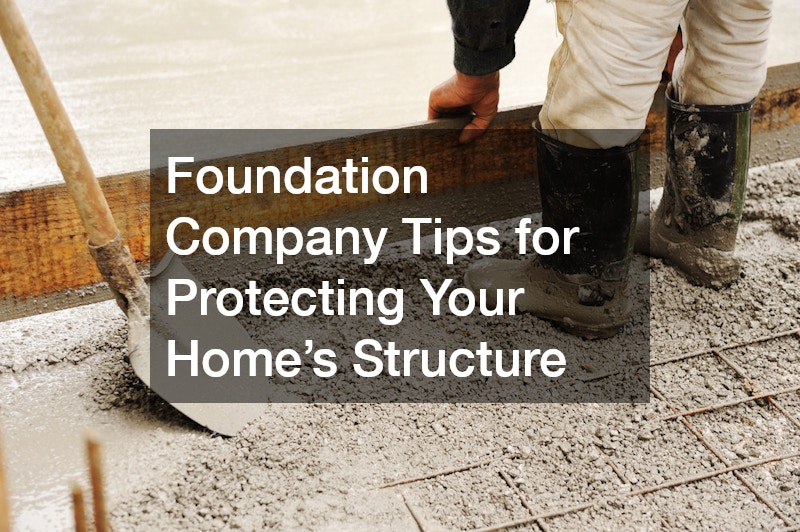Foundation Company Tips for Protecting Your Homes Structure

The structural integrity of your home is essential for safety and longevity. Proper foundation care is a crucial aspect of maintaining a strong and stable home. In this article, we explore top tips from a foundation company to help protect your home’s structure.
Identifying Common Signs of Foundation Issues
The foundation of a home is its underlying support system, and even minor issues can lead to significant structural damage. One of the most common signs of foundation problems is the appearance of cracks in walls, which can vary from small hairline fractures to large, noticeable gaps.
Additionally, misaligned doors and windows that jam or fail to latch properly can indicate foundation movement or settling.
Another concerning sign of foundation trouble is uneven or sloping floors. If you notice that furniture or objects slide without cause, this may be due to an underlying foundation issue. Moreover, the appearance of spaces between walls and ceilings or floors, as well as baseboards separating from walls, can also be indicators of foundation complications.
When to Conduct Professional Inspections
Professional inspections are vital in ensuring the foundation’s health and in identifying problems that might not be visible to the untrained eye. Experts recommend conducting a comprehensive foundation inspection every two to three years or immediately if you notice any signs of distress. These inspections often include checking the exterior and interior of a property for cracks, water damage, and other irregularities that suggest foundation movement or instability.
Many homeowners wait until visible signs appear, but proactive inspections can catch problems early, saving money and stress in the long run. During the inspection, a professional may use specialized equipment and technologies, such as laser levels or moisture meters, to ensure a thorough evaluation. By scheduling regular inspections, homeowners can understand their home’s condition better and take preemptive measures if required.
DIY Tools and Techniques for Assessment
While professional inspections are recommended, homeowners can conduct initial assessments using basic tools and techniques. A flashlight and tape measure can help identify obvious signs like wall cracks and measures their growth over time. Additionally, a level can be used to detect sloping floors, which might indicate foundation problems.
Homeowners should also inspect the exterior of their home, checking for gaps between bricks or concrete blocks. Another useful technique is the door and window test; if these do not open or close easily or appear misaligned, it could suggest foundation movement. Regular monitoring and documenting of these findings can help homeowners notice trends or patterns that suggest issues are developing.
Maintaining Proper Drainage
Proper drainage is a cornerstone in maintaining foundation health, preventing water from pooling around the base of a home. Homes should have well-installed drainage systems, such as gutters and downspouts, to direct water away from the foundation. It’s crucial to regularly clean and maintain these systems to ensure they function correctly, especially after storms or significant rainfall.
Slope grading around the home also plays a vital role in effective drainage. Soil should ideally slope away from the foundation to facilitate water runoff and prevent moisture accumulation. Homeowners should regularly check for areas where drainage is insufficient and consider installing drains or trenches as necessary.
Controlling Vegetation and Landscaping
Vegetation near a home’s foundation can significantly impact its structural health. Large trees and shrubs can cause damage with their roots as they grow toward the foundation, in search of moisture. These expanding roots can create pressure and disruptions, leading to cracks and shifts in the foundation.
To mitigate this risk, it’s best to plant large trees and shrubs at a safe distance from the house. Regular trimming and maintenance can also help to control how vegetation interacts with the foundation. Selecting plants with less invasive root systems for landscaping can further reduce potential impacts on the foundation.
Understanding Piering and Underpinning
Piering and underpinning are highly effective methods for repairing sinking or settling foundations. Piering involves driving steel piers into the ground to reach stable soil layers, effectively supporting and lifting the foundation. Underpinning, on the other hand, involves reinforcing the existing foundation by extending it deeper.
Both methods provide long-lasting solutions by reaching depths where soil conditions are stable, counteracting settlement due to weak or shifting soils. These techniques are recommended for significant structural issues and should be performed by qualified professionals. Homeowners can rest assured knowing that piering and underpinning offer durable corrective measures.
Evaluating Permanent vs Temporary Solutions
When addressing foundation issues, it’s essential to differentiate between permanent and temporary solutions. Permanent solutions, such as piering and underpinning, address the root cause of foundation problems and ensure long-term stability. On the other hand, temporary solutions may provide short-term relief but often require ongoing maintenance or additional interventions.
A well-maintained foundation is crucial for the safety, stability, and longevity of your home. By following these tips and seeking professional help when necessary, you can effectively protect and sustain your home’s structure for years to come. With informed decision-making and regular maintenance, you can safeguard your investment and ensure a safe living environment.



